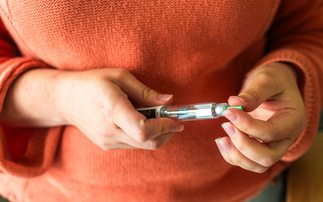The digestive system breaks down solid food to provide the body with important nutrients - so what happens when it fails to work as effectively as it should? Clare Guy reports.
The human digestive system's overall function is to break down solid food into chemical substances that can be absorbed easily into the body. It is made up of a group of organs, with each responsible for a different part of the digestive process.
The oesophagus pushes food down to the stomach by a muscular action known as peristalsis, while the stomach churns food - the first part of digestion. The small intestine is made up of the duodenum, jejunum and ileum and is a major site of digestion and absorption of food. The colon or large intestine reabsorbs water from undigested food, which assists the formation of solid waste, as well as producing vitamins and storing and eliminating faeces.
Digestion is very important, as the chemical substances it produces are used to build and nourish cells and provide energy.
Coeliac disease is an inflammatory disease of the small intestine, and is caused by hypersensitivity to gluten. If a person who has coeliac disease eats gluten, their body treats it as a harmful substance and produces antibodies to attack it, which in turn damages the lining of the small intestine. This results in the body being unable to absorb as many nutrients as it should be able to, which can lead to diarrhoea and malnutrition.
Symptoms and severity
The symptoms and severity of coeliac disease can range from mild to severe, with some people never developing symptoms. In adults, symptoms develop gradually and can include weight loss, abdominal distension, fatty diarrhoea, tiredness, anaemia, vomiting, abdominal pain and mouth ulcers.
Coeliac disease often runs in families, and severe stress, physical injury, infection, pregnancy, childbirth or surgery can lead to symptoms developing.
Examining the history of the symptoms experienced, as well as taking a special blood test and biopsy from the lining of the small intestine, can be used to make a diagnosis of coeliac disease.
The illness is usually treated by removing gluten from the diet for life, although in some cases additional treatment may be required.
Another inflammatory disease that can occur in any part of the gastrointestinal tract - oesophagus, stomach and the small and large intestine - is Crohn's disease. This disease is unpredictable, typically chronic and relapsing, although a complete remission may occur. Symptoms are caused by the inflammation of the affected part of the gastrointestinal tract and may include pain, ulcers, diarrhoea, fever and tiredness, loss of appetite, weight loss, anaemia, anal fissure and rectal bleeding.
In some cases, symptoms may appear away from the gastrointestinal tract, and joint or liver inflammation, skin rashes and gallstones may occur. The severity and type of the symptoms experienced vary depending what area is affected.
The cause of Crohn's disease is unknown, and sometimes the distinction between Crohn's disease and ulcerative colitis is difficult. Crohn's disease can be diagnosed by sigmoidoscopy, colonoscopy, endoscopy, barium enema/meal, a biopsy taken from the affected area of the gastrointestinal tract and stool or blood tests.
The treatment for Crohn's disease depends on the area of the gastrointestinal tract that is involved, in addition to the severity of the disease. Its treatment can include changes to the affected person's diet, oral corticosteroids, antibiotics or surgery.
Ulcerative colitis, an inflammatory disease of the colon (large intestine), can in severe cases result in ulcers forming on the lining of the colon. Ulcerative colitis is unpredictable - sufferers can have a flare up of symptoms and then go into remission for months or years.
The symptoms and severity of ulcerative colitis varies, but can include anaemia, abdominal pain, tiredness, weight loss, loss of appetite, rectal bleeding, fever, bloody diarrhoea, de-hydration, skin lesions, joint pain and a constant desire to empty the bowels (tenesmus). In some cases, extra-colonic symptoms such as joint pain, liver or eye disease, aortitis, skin and oral lesions may be noted. For some individuals, ulcerative colitis can also lead to an increased risk of developing colorectal cancer or toxic megacolon.
The exact cause is unknown, although it is thought that genetic and environmental factors could be involved. It can be diagnosed via studying the history of symptoms, blood or stool tests, sigmoidoscopy, colonoscopy and biopsy. The extent of the disease can then be established by barium enema or colonoscopy.
The following terms may be used to classify the extent of the ulcerative colitis:
n Proctosigmoiditis - disease involving the distal 30cm of colonic mucosa (rectum and sigmoid colon).
n Left-sided colitis - extension of inflammation up to splenic flexure.
n Pancolitis (universal or total) - disease extension to and beyond the hepatic flexure; total colonic involvement.
Ulcerative colitis can be treated either medically or surgically. Medical treatment can include oral corticosteroids or maintenance therapy, while surgery can be elective or as an emergency in the case of a severe attack.
Facts and Figures
n Humans eat approximately 500kg (½ ton) of food per year.
n Muscles contract in waves (peristalsis) to move the food down the oesophagus. This means that food will reach a person's stomach, even if they were standing on their head.
n An adult stomach can hold approximately 1.5 litres (2 ½ pints) of material.
n The digestive system of an adult human is about 8m long.
n Every day, 11.5 litres (20 pints) of digested food, liquids and digestive juices flow through the digestive system, but only 100mls (one-sixth of a pint) is lost in faeces.
n The small intestine is the longest part of the digestive tract (about 6m long) but it has a smaller diameter than the large intestine.
n The large intestine is approximately 1.7m long and 6.5cm thick.
n Coeliac disease affects approximately one in 100 people in the UK. There is an increased risk of one in 10 of developing coeliac disease when it exists in the family.
n Approximately one in 1,500 people have Crohn's disease.
n Around 100,000 people in the UK have ulcerative colitis, and the condition normally appears between the ages of 15-30.
n Toxic megacolon occurs in approximately 5% of cases of severe ulcerative colitis.
n After 10 years of having ulcerative colitis, the risk of developing colorectal cancer is 2%, after 20 years the risk of developing colorectal cancer is 8% and after 30 years the risk of developing colorectal cancer is 18%. n
Clare Guy is life and disability underwriter at Aegon Scottish Equitable
Sources
Swiss Re Underwriting Manual - Lifeguide
www.sciencepages.co.uk
www.askoxford.com
www.medic8.com
www.coeliac.co.uk
www.crohns.org.uk
www.ulcerativecolitis.org.uk
Oxford Concise Medical Dictionary











